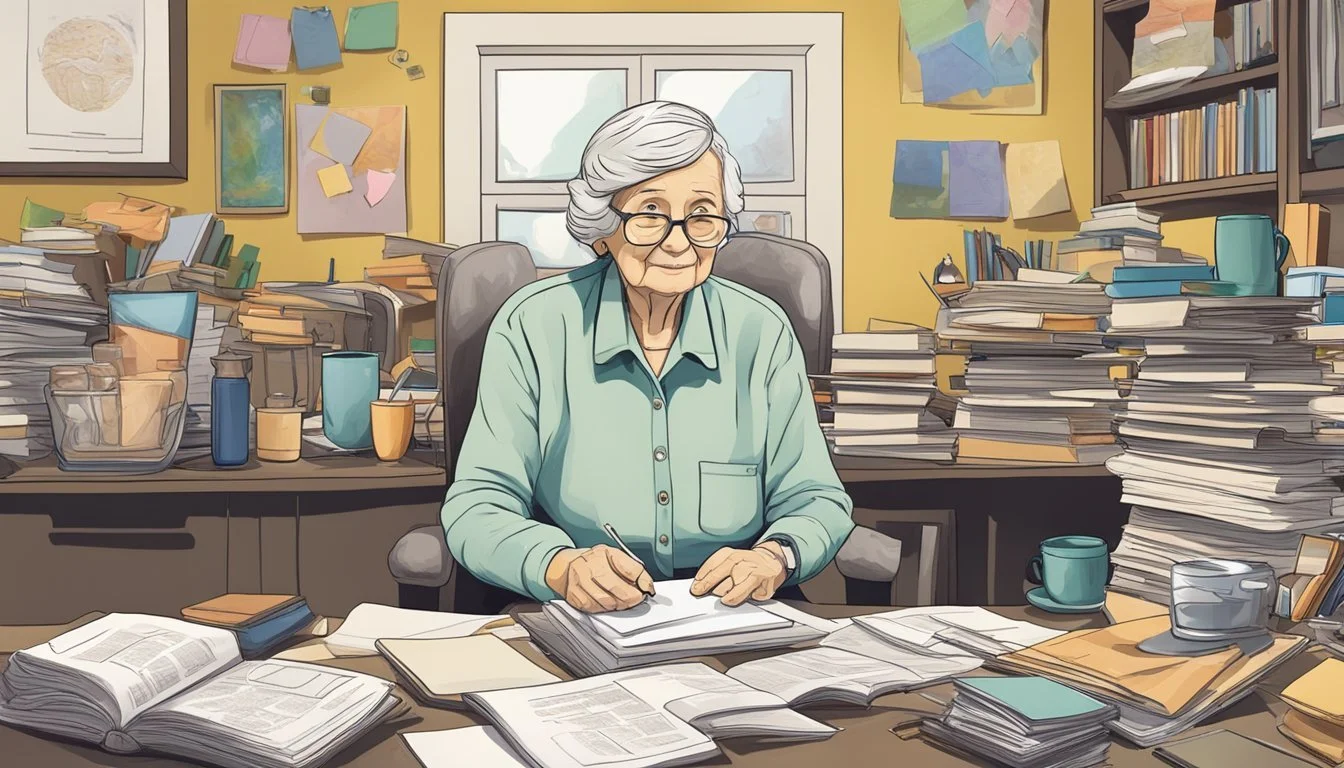Hoarding Disorder in Old Age: Understanding Its Impact and Challenges
Hoarding disorder affects approximately 2-6% of the general population, with higher rates among older adults. This condition, characterized by difficulty discarding possessions and excessive accumulation of items, can significantly impact an individual's quality of life. Studies suggest that hoarding tends to worsen with age, often becoming more severe in later life.
The onset of hoarding symptoms typically occurs in early adulthood, but may go unnoticed until later years. For some older adults, hoarding behaviors can emerge or intensify as a response to the emotional complexities of aging. This may serve as a coping mechanism for dealing with life changes, loss, or anxiety about the future.
Recognizing hoarding disorder in older adults is crucial for providing appropriate support and intervention. As the condition progresses, it can lead to unsafe living conditions, social isolation, and increased health risks. Understanding the unique challenges faced by elderly individuals with hoarding tendencies is essential for developing effective treatment strategies and improving their overall well-being.
Understanding Hoarding Disorder
Hoarding disorder is a complex mental health condition characterized by persistent difficulty discarding possessions, regardless of their actual value. It often leads to excessive accumulation of items and cluttered living spaces.
Definition and Diagnostic Criteria
Hoarding disorder involves a strong urge to acquire and save items, coupled with extreme distress at the thought of discarding them. The Diagnostic and Statistical Manual of Mental Disorders (DSM-5) outlines specific criteria for diagnosis:
Persistent difficulty discarding possessions
Perceived need to save items and distress associated with discarding them
Accumulation of items that congest living areas
Significant distress or impairment in daily functioning
These symptoms must not be better explained by another medical condition or mental disorder.
Prevalence in the Elderly
Hoarding disorder affects approximately 2-6% of the general population, with higher rates observed in older adults. Studies suggest prevalence rates up to 6.2% in individuals over 55 years old.
The condition tends to worsen with age, often becoming more severe in later life. Onset typically occurs in childhood or adolescence, but symptoms may not become clinically significant until later adulthood.
Factors contributing to increased prevalence in the elderly include:
Cognitive decline
Social isolation
Loss of loved ones
Reduced mobility
Distinguishing Characteristics
Hoarding disorder has unique features that set it apart from other conditions:
Lack of insight: Many individuals with hoarding disorder don't recognize their behavior as problematic
Emotional attachment to possessions: Items are often imbued with sentimental value or perceived usefulness
Impaired decision-making: Difficulty categorizing items and deciding what to keep or discard
Perfectionism: Fear of making mistakes when discarding items
While sharing some similarities with obsessive-compulsive disorder (OCD), hoarding disorder is classified as a distinct condition. Studies show 15-30% of people with hoarding disorder also meet criteria for OCD.
Hoarding behaviors in the elderly may serve as coping mechanisms for emotional challenges associated with aging. The accumulation of possessions can provide a sense of security and control in the face of life changes and losses.
Causes and Risk Factors
The development of hoarding disorder in older adults stems from a complex interplay of genetic, psychological, and environmental factors. These influences often accumulate over time, leading to more severe symptoms in later life.
Genetic and Biological Influences
Studies suggest a genetic component to hoarding disorder. Individuals with a family history of hoarding are more likely to develop the condition. Brain imaging research has revealed differences in neural activity among people with hoarding tendencies, particularly in areas associated with decision-making and emotional attachment to objects.
Certain neurological conditions, such as dementia or brain injuries, can increase the risk of hoarding behaviors in older adults. These conditions may affect cognitive functions related to organizing, planning, and decision-making.
Psychological and Emotional Triggers
Anxiety and depression often co-occur with hoarding disorder in the elderly. These conditions can amplify the emotional attachment to possessions and increase difficulty in discarding items.
Perfectionism and indecisiveness play significant roles. Older adults with hoarding tendencies may struggle to make decisions about what to keep or discard, fearing they might need items in the future.
Past traumatic experiences or a history of material deprivation can contribute to excessive acquisition and retention of objects as a coping mechanism.
Life Events and Loss
Major life transitions common in older age, such as retirement or the death of a spouse, can trigger or exacerbate hoarding behaviors. These events may lead to increased isolation and a stronger reliance on possessions for comfort and security.
The loss of physical or cognitive abilities can make it more challenging for older adults to manage their belongings effectively. This difficulty can contribute to the accumulation of items over time.
Reduced social connections in later life may result in forming stronger attachments to objects as substitutes for human relationships, further reinforcing hoarding tendencies.
Impact on Health and Well-being
Hoarding disorder in old age can severely impact physical and mental health. It often leads to unsafe living conditions and social isolation, creating a cascade of negative effects on overall well-being.
Physical Health Consequences
Cluttered living spaces pose serious safety hazards for older adults with hoarding disorder. Piles of items increase the risk of falls, which can be particularly dangerous for the elderly. Fire hazards are also common due to blocked exits and flammable materials.
Poor sanitation is another concern. Accumulated items can harbor dust, mold, and pests, leading to respiratory issues and allergies. In severe cases, basic hygiene becomes difficult, increasing the risk of infections and skin conditions.
Hoarding can also interfere with medical care. Cluttered environments may prevent emergency responders from reaching the individual quickly. Additionally, excessive clutter can make it challenging to maintain medical equipment or follow treatment plans effectively.
Mental Health Considerations
Hoarding disorder is often accompanied by other mental health issues. Depression and anxiety are common co-occurring conditions, exacerbated by the stress of living in a cluttered environment.
Cognitive decline may both contribute to and result from hoarding behaviors. The inability to organize and make decisions can worsen over time, creating a cycle of accumulation and disorganization.
Shame and embarrassment about living conditions can lead to avoidance of social interactions and reluctance to seek help. This isolation can further deteriorate mental health and cognitive function.
Treatment often involves cognitive-behavioral therapy to address underlying thought patterns and behaviors associated with hoarding. Medications may be prescribed to manage co-occurring mental health conditions.
Social Isolation and Stigmatization
Hoarding disorder frequently leads to social isolation. Older adults may feel ashamed of their living conditions and avoid inviting friends or family into their homes. This isolation can worsen depression and cognitive decline.
Relationships with family members and neighbors may become strained due to the impact of hoarding behaviors. Conflicts over clutter and safety concerns can lead to further withdrawal from social interactions.
Stigma surrounding hoarding disorder can prevent individuals from seeking help. Many feel misunderstood or judged, leading to increased secrecy and resistance to intervention.
Community support and education are crucial in addressing stigma. Support groups can provide a safe space for individuals to share experiences and coping strategies. Educating family members and caregivers about the nature of hoarding disorder can improve understanding and support.
Clinical Evaluation
Clinical evaluation of hoarding disorder in older adults requires specialized assessment tools, careful differential diagnosis, and a multidisciplinary approach. Proper evaluation is crucial for accurate diagnosis and effective treatment planning.
Assessment Tools and Techniques
Clinicians use various tools to assess hoarding disorder in the elderly. The Clutter Image Rating (CIR) provides a visual scale to evaluate clutter severity. The Saving Inventory-Revised (SI-R) measures difficulty discarding, excessive acquisition, and clutter. The Activities of Daily Living in Hoarding (ADL-H) assesses functional impairment.
Home visits are essential for accurate assessment. They allow clinicians to observe the living environment firsthand and gauge the extent of clutter. Interviews with family members or caregivers can provide additional insights into the patient's behavior and its impact on daily life.
Cognitive assessments, such as the Montreal Cognitive Assessment (MoCA), help evaluate cognitive function. This is particularly important in older adults to distinguish hoarding from cognitive decline.
Differential Diagnosis
Distinguishing hoarding disorder from other conditions is crucial. Depression, obsessive-compulsive disorder (OCD), and dementia can present with similar symptoms. Clinicians must rule out medical causes that may contribute to hoarding behaviors.
Brain imaging, such as CT scans, can help identify neurological issues. White matter changes, often seen in older adults, may be relevant to hoarding behaviors.
Hoarding as a symptom of dementia typically has a later onset and more rapid progression compared to primary hoarding disorder. The pattern of acquisition and inability to discard items may differ between the two conditions.
Multidisciplinary Evaluation Approach
A comprehensive evaluation often involves multiple professionals. Psychiatrists assess mental health and prescribe medications if needed. Psychologists conduct cognitive and behavioral assessments. Occupational therapists evaluate the impact of hoarding on daily functioning.
Social workers assess the patient's support system and living conditions. They can also help coordinate community resources. Geriatricians provide expertise in age-related health issues that may influence hoarding behaviors.
Case conferences allow the team to share findings and develop a holistic treatment plan. This approach ensures all aspects of the patient's health and well-being are considered in the evaluation process.
Treatment Strategies
Effective treatment for hoarding disorder in older adults involves a multi-faceted approach. Key strategies focus on addressing cognitive and behavioral patterns, managing associated mental health issues, and providing support systems.
Cognitive Behavioral Therapy
Cognitive Behavioral Therapy (CBT) is the primary treatment for hoarding disorder in seniors. This approach helps individuals identify and change harmful thought patterns and behaviors related to acquiring and discarding possessions.
CBT sessions often include techniques like exposure therapy, where patients gradually confront their anxiety about discarding items. Therapists may also use cognitive restructuring to challenge beliefs about the need to save objects.
Home visits are frequently incorporated into CBT for hoarding. These allow therapists to assess the living environment and provide practical guidance on organizing and decluttering.
Medication Management
While no specific medication treats hoarding disorder, certain drugs may help manage associated symptoms or co-occurring conditions. Selective serotonin reuptake inhibitors (SSRIs) are sometimes prescribed to address anxiety or depression linked to hoarding behaviors.
For older adults, careful consideration of potential side effects and drug interactions is crucial. Doctors may start with lower doses and adjust as needed.
Medication is typically used in conjunction with therapy rather than as a standalone treatment. Regular monitoring and follow-ups are essential to assess effectiveness and make necessary adjustments.
Support Groups and Counseling
Support groups offer valuable peer connections for older adults struggling with hoarding. These groups provide a safe space to share experiences, coping strategies, and progress.
Many support groups follow a structured format, incorporating elements of CBT or motivational interviewing. Some are led by mental health professionals, while others are peer-facilitated.
Family counseling can be beneficial, helping loved ones understand the disorder and develop strategies to support the affected individual. It can also address family dynamics that may contribute to or be affected by hoarding behaviors.
Online support groups and resources have become increasingly available, offering accessibility for those with mobility issues or limited transportation options.
Challenges in Treatment and Intervention
Treating hoarding disorder in older adults presents unique obstacles that require tailored approaches. Several key factors complicate intervention efforts and impact treatment outcomes for elderly individuals with this condition.
Patient Resistance and Insight
Many older adults with hoarding disorder struggle to recognize the severity of their behavior. This lack of insight often leads to resistance to treatment. They may view their possessions as valuable or necessary, making it difficult to part with items.
Cognitive decline associated with aging can further impair judgment and decision-making abilities. This exacerbates the challenge of helping patients understand the need for intervention.
Fear of change and loss of control are common barriers. Elderly hoarders may feel anxious about altering their living environment or routines.
Building trust and rapport with patients is crucial. Therapists must approach treatment sensitively to avoid triggering defensive reactions or withdrawal.
Caregiver Involvement and Support
Family members and caregivers play a vital role in treating elderly hoarders. However, their involvement can be both beneficial and challenging.
Caregivers often experience high levels of stress and burnout. Managing a loved one's hoarding behavior alongside other age-related health issues can be overwhelming.
Conflict between caregivers and patients is common. Disagreements about the need for intervention or the disposal of items can hinder progress.
Education and support for caregivers are essential. Teaching effective communication strategies and coping skills can improve treatment outcomes.
Balancing patient autonomy with caregiver concerns requires careful navigation. Respecting the older adult's independence while addressing safety issues is a delicate task.
Legal and Ethical Considerations
Hoarding in older adults can raise complex legal and ethical dilemmas. Balancing personal freedom with safety concerns is a significant challenge.
In severe cases, hoarding may violate housing codes or create health hazards. This can lead to eviction threats or involvement of adult protective services.
Determining an elderly person's capacity to make decisions about their living situation is often necessary. This process can be emotionally charged and legally complex.
Forced cleanouts or involuntary interventions are controversial. These actions may cause psychological distress and damage therapeutic relationships.
Protecting vulnerable older adults while respecting their rights requires careful consideration. Multidisciplinary approaches involving mental health professionals, social workers, and legal experts are often necessary.
Prevention and Education
Preventing hoarding disorder in older adults requires a multifaceted approach involving community support, family involvement, and the promotion of healthy habits. Early intervention and education can significantly reduce the risk of hoarding behaviors developing or worsening in later life.
Community Awareness Programs
Community awareness programs play a crucial role in prevention efforts. These initiatives aim to educate the public about hoarding disorder, its signs, and available resources. Local health departments and mental health organizations often host workshops and seminars to raise awareness.
Senior centers frequently offer informational sessions on decluttering and organizing. These programs provide practical tips for maintaining a clutter-free living space. Libraries and community centers may display educational materials and resource lists for easy access.
Some communities implement neighborhood watch programs specifically focused on identifying potential hoarding situations. This allows for early intervention and support before the problem escalates.
Role of Family and Friends
Family members and friends are often the first to notice hoarding tendencies in older adults. Their support is essential in prevention and early intervention. Loved ones can encourage healthy habits and gently discourage excessive acquisition of items.
Regular visits to an older adult's home can help monitor the living situation. Family members should be alert to signs of clutter accumulation or difficulty discarding items. Open communication about concerns is important, but it must be done with sensitivity and without judgment.
Offering assistance with organizing or decluttering can be helpful. However, it's crucial to respect the individual's autonomy and not force unwanted changes. Family members can also help connect older adults with professional resources if needed.
Promoting Healthy Habits
Developing and maintaining healthy habits can prevent hoarding behaviors from taking root. Encouraging regular social interactions can reduce isolation, a risk factor for hoarding. Participation in community activities or volunteer work can provide a sense of purpose and connection.
Stress management techniques like meditation or yoga can help older adults cope with anxiety, often associated with hoarding. Regular exercise and maintaining a balanced diet contribute to overall mental health and well-being.
Establishing routines for organizing and decluttering can prevent the accumulation of items. This might include a weekly sorting of mail or a monthly review of belongings. Encouraging the use of digital storage for documents and photos can reduce physical clutter.
Future Directions
Advancing research, technology, and policy will shape the future of hoarding disorder treatment in older adults. Key areas of focus include clinical trials, innovative interventions, and advocacy efforts to improve care and support.
Research and Clinical Trials
New studies are exploring targeted therapies for elderly individuals with hoarding disorder. Researchers are investigating cognitive behavioral approaches adapted for older adults' needs and capabilities. Clinical trials are testing the effectiveness of medication combinations to address both hoarding behaviors and common co-occurring conditions like depression.
Longitudinal studies aim to track the progression of hoarding symptoms over time in aging populations. This research could reveal critical intervention points and risk factors specific to late-life hoarding.
Neuroimaging studies seek to uncover age-related brain changes associated with hoarding tendencies. Understanding these neural mechanisms may lead to more precise diagnostic tools and treatments.
Technological Innovations
Digital platforms are emerging as promising tools for hoarding disorder management in older adults. Virtual reality exposure therapy allows individuals to practice decluttering in simulated environments, reducing anxiety around discarding items.
Smart home technologies can help monitor clutter levels and provide gentle reminders to organize living spaces. These systems may be particularly useful for elderly individuals living independently.
Mobile apps are being developed to support cognitive behavioral therapy exercises and track progress between therapy sessions. These tools can increase engagement and provide valuable data for clinicians.
Artificial intelligence algorithms show potential for early detection of hoarding behaviors through analysis of shopping patterns and home sensor data.
Policy and Advocacy
Efforts are underway to increase Medicare coverage for hoarding disorder treatment in older adults. Advocacy groups are pushing for expanded access to specialized therapy and support services.
Public health initiatives aim to raise awareness of hoarding as a mental health issue affecting the elderly. These campaigns seek to reduce stigma and encourage early intervention.
New guidelines for social services and healthcare providers focus on age-appropriate screening and referral processes for hoarding disorder. Implementation of these protocols could improve identification and treatment rates among older adults.
Proposed legislation addresses the need for specialized training for home health aides and elder care professionals in recognizing and responding to hoarding behaviors.







